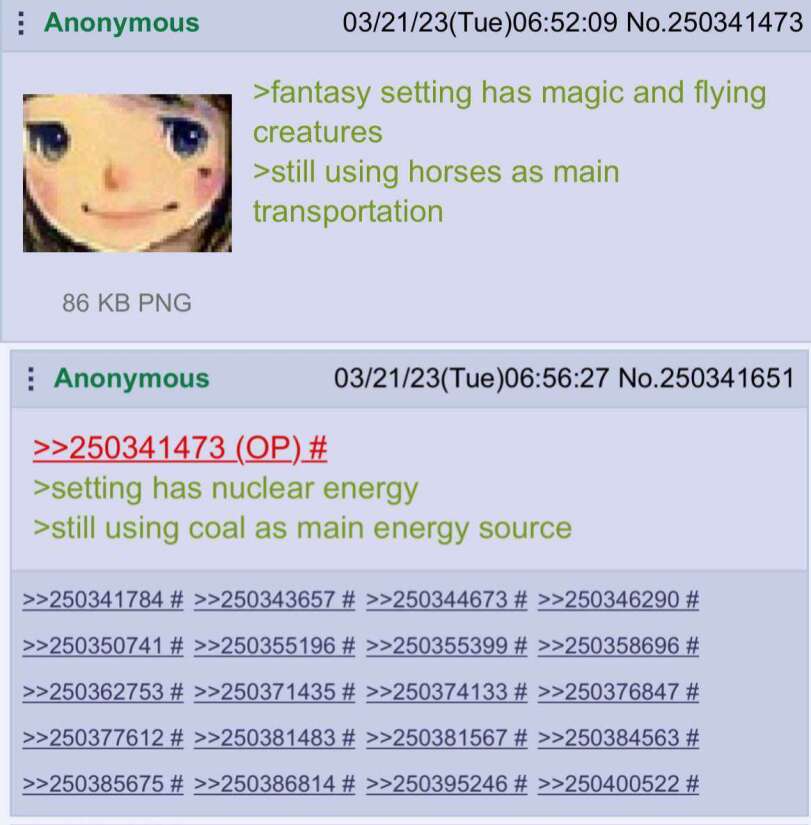this post was submitted on 29 Mar 2024
1199 points (97.7% liked)
Greentext
4329 readers
1448 users here now
This is a place to share greentexts and witness the confounding life of Anon. If you're new to the Greentext community, think of it as a sort of zoo with Anon as the main attraction.
Be warned:
- Anon is often crazy.
- Anon is often depressed.
- Anon frequently shares thoughts that are immature, offensive, or incomprehensible.
If you find yourself getting angry (or god forbid, agreeing) with something Anon has said, you might be doing it wrong.
founded 1 year ago
MODERATORS
you are viewing a single comment's thread
view the rest of the comments
view the rest of the comments

So, what you're talking about here is essentially the concept of "baseload power", which is a very common talking point in anti-renewables conversation, including by well-meaning people who have simply come to accept it because of how often it gets mentioned in the media and in online conversations.
But it turns out that we have known for over a decade that a mix of different renewable technologies do not need any base-load power stations to operate reliably.
From your article:
So basically the concentrated solar w/ thermal storage acts as a battery. I'm interested to know what the costs look like (is that the salt reactor thing I've heard about). And if you have lots of hydro available, then yeah, you can probably get away with it, and may even be able to pump water so the hydro station can act as a battery. However, hydro isn't practical in many areas, and moving electricity long distances may be too lossy.
I'm interested in the development of nuclear microreactors, which can be transported where they're needed. I think they could potentially replace hydro in areas where it's not available. So as areas transition to more renewables, these could operate as a backup in case simulations don't match reality.
I'd love to go 100% renewable, I just don't think that's feasible at the moment. But I could absolutely be wrong, I may need to read up on the latest energy storage options.
Rubbish dump methane to electricity is cheap and effective. The Canberra mugga lane tip has had a pilot plant~~, not sure if it's still running~~ generating 37 GWh a year
Hydro on the mainland is pretty much just Snowy Hydro. There was a project from a former government to make that pumped hydro. I don't think it has yet been finished. I don't know whether the project has been cancelled
37 GWh, now that's a "random" number
Solar thermal - yes, the leading technology is a field of heliostat mirrors focusing sunlight on a tower, melting and heating salt. That system can easily hold onto the heat in their salt for use at night
CSIRO in 2014 thought it was possible. I trust they did the maths right.
You can extract hydrogen from water with electricity. You can store hydrogen in tanks. Burn hydrogen to produce electricity similar to natural gas, except without any carbon in the equation.
The main problem is storage since hydrogen is so small. But yeah, it's absolutely a great idea as a battery of sorts, I just don't know what the costs look like.
I think mobile applications make more sense though, so things like trucks and forklifts. Those really benefit from quick refuels, so they could fit into places where fossil fuels dominate today.
Yes that is the problem. Maybe there's some chemistry that could help with this? I don't know I'm not a chemical engineer.
Also airplanes. Jet engines can run on hydrogen with little to no conversion. Problem there is the low density of hydrogen means airplanes need to be redesigned to have much larger tanks, and cryogenics need to be involved. Airbus has some ideas about this, but it's still very much in the concept phase.
But for transport trucks there's an interesting solution being tested in Germany where overhead wires are run over the highways, similar to overhead wires for trains. Trucks connect to that when on the highway. So the trucks would only need battery for making stops then they're off the highway and would recharge again when back on the highway. Seems like a good solution to me, but it's still being tested.
But hydrogen could replace natural gas for heating and for those who refuse to give up their gas stoves. But as you say, it's small so the gas pipes would need to be upgraded to have tighter seals for that to work.
Hydrogen is too inefficient for homes, the better bet imo is a hard sell for induction cooktops. Hydrogen is just too hard to transfer (doesn't compress nicely), inefficient to produce, and there's going to be leakage issues.
It's much better to produce that hydrogen very close to where it'll be used. I'm imagining areas with lots of factories and whatnot producing hydrogen with excess solar and using it on site. The losses would be worth it because it's probably cheaper than batteries (esp considering time to charge batteries, runtime of equipment, etc).